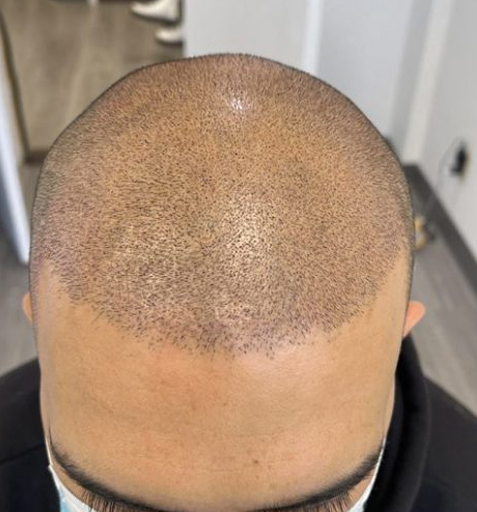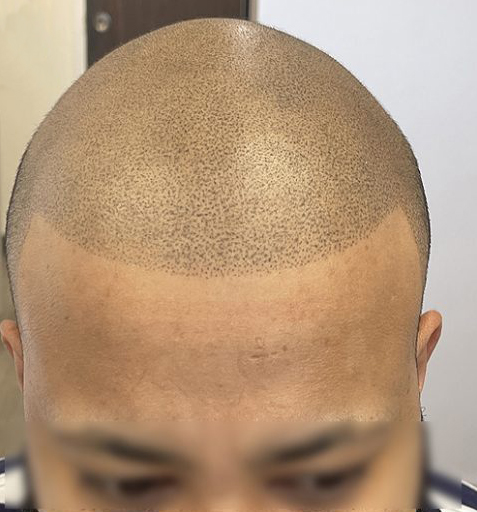Table of Contents
Alopecia Areata is a condition where the immune system mistakenly attacks healthy hair follicles which causes hair loss in round patches. The immune system attacks healthy hair follicles. This condition affects people of all ages and genders. The exact cause remains unclear, but genetics and stress contribute. Many people feel embarrassed or anxious because of visible bald spots.
Doctors often recommend medications or injections to treat this condition. These treatments can have side effects and may not work for everyone. Scalp Micropigmentation (SMP) offers a different option. This procedure gives the appearance of fuller hair. The results are immediate and require no recovery time. You may find SMP to be a simple and effective solution.
Table of Contents
Alopecia Areata is an autoimmune disorder that causes hair loss. The body’s immune system attacks hair follicles. Hair loss happens in small, round patches on the scalp. Eyebrows, eyelashes, and facial hair may also be affected. Some people lose only a few patches of hair. Others experience more widespread hair loss.
Doctors do not fully understand the cause of this condition. Stress or family history can increase the risk. Some people experience hair regrowth within months. Others face long-term or recurring hair loss. Alopecia Areata differs from pattern baldness. The emotional impact of this condition can be severe. Scalp Micropigmentation helps reduce visible baldness and restores confidence.
Scalp Micropigmentation creates the appearance of hair follicles. A specialist uses tiny needles to apply pigment to the scalp. This process mimics the look of natural hair. The treatment covers bald patches caused by Alopecia Areata.
The pigment colour matches your natural hair. A specialist customizes the treatment to blend with existing hair. The procedure works for small patches or larger areas of hair loss. It also creates the appearance of an even hairline.
A consultation with an SMP specialist is the first step. The specialist assesses your scalp and recommends a plan. The treatment involves several sessions to apply layers of pigment. The results look natural and last for years. Scalp Micropigmentation offers immediate results without surgery or recovery time.
Scalp Micropigmentation provides immediate improvement. The results are visible after the first session. Unlike other treatments, SMP requires no waiting for progress. The procedure helps you regain confidence right away.
SMP does not involve surgery or incisions. A specialist applies pigments to your scalp with precision. The process eliminates the risks associated with surgery. You can enjoy the benefits without a long recovery period.
Every treatment is tailored to meet individual needs. A specialist examines the pattern of hair loss and adjusts accordingly. The pigment blends with your hair to create a natural look. This flexibility makes SMP an effective choice for various hair loss patterns.
Hair loss often lowers self-esteem. SMP restores the appearance of a full scalp. You can feel more confident in social and professional situations. Many people report significant emotional relief after the treatment.
SMP requires minimal upkeep. The results last for years with only occasional touch-ups. You do not need daily products or treatments. This makes SMP a convenient and long-lasting solution.
SMP immediately gives the appearance of fuller hair. The pigments look natural and blend with existing hair. The results typically last three to five years.
The scalp may feel sensitive or appear red for a day after the procedure. Redness fades quickly, and most people return to normal activities within 48 hours. Specialists advise avoiding heavy sweating and direct sun exposure during the healing process.
Touch-up sessions help maintain the desired look. These sessions refresh the pigments as they gradually fade. Most people find the long-lasting results of SMP highly satisfying.
SMP offers cosmetic benefits but does not treat the root cause of Alopecia Areata. Active hair loss may require stabilization before starting the treatment.
Some people may not qualify for SMP. Open wounds, scalp infections, or severe scarring could interfere with the procedure. An experienced specialist evaluates these conditions before proceeding.
The pigments fade over time and require touch-ups. Despite this, SMP remains a reliable and effective solution. The results provide a natural appearance that boosts confidence.
Many people report significant improvements after SMP. Individuals with visible bald patches regain a fuller-looking scalp. Before-and-after results show dramatic transformations. Testimonials often highlight emotional benefits. People feel more comfortable and confident after the procedure.
SMP has helped people improve their quality of life. The treatment allows them to participate more freely in social and professional activities. The success of SMP reflects its value as an alternative to traditional treatments.
The SMP cost depends on the size of the treatment area. Full scalp procedures usually range from $1,500 to $4,000. The location of the clinic and the specialist’s experience affect pricing. Some people require multiple sessions, which may increase costs.
Compared to hair transplants, SMP is more affordable. Ongoing expenses for medications or wigs also add up over time. SMP provides a long-term, cost-effective solution to hair loss.
SMP has minimal risks when performed by professionals. Some people experience redness or mild sensitivity after the procedure. These effects usually disappear within a day or two.
An experienced specialist uses high-quality equipment to reduce risks. Poor technique or improper tools can lead to uneven pigmentation or infection. Following aftercare guidelines helps improve results and minimizes side effects.
Scalp Micropigmentation offers a transformative solution for those suffering from Alopecia Areata, providing a natural-looking, immediate cosmetic fix that can significantly improve appearance and confidence. While it does not cure the underlying condition, SMP allows individuals to manage the visible effects of hair loss and achieve a fuller-looking scalp.
If you’re dealing with Alopecia Areata and are looking for a low-maintenance, non-invasive treatment option, SMP may be the right choice to help you regain your self-esteem.
No, SMP does not cure Alopecia Areata. It only provides a cosmetic solution.
The results typically last three to five years. Touch-ups refresh the pigments as needed.
Most people feel mild discomfort. The sensation is similar to light scratching on the scalp.
SMP works best when hair loss has stabilized. Active shedding may affect the outcome.
You can return to normal activities within 48 hours. Specialists recommend avoiding heavy sweating and sun exposure during healing.






© 2024 HAIRTATTOO.CA | Scalp Micropigmentation & Trichology Centre
